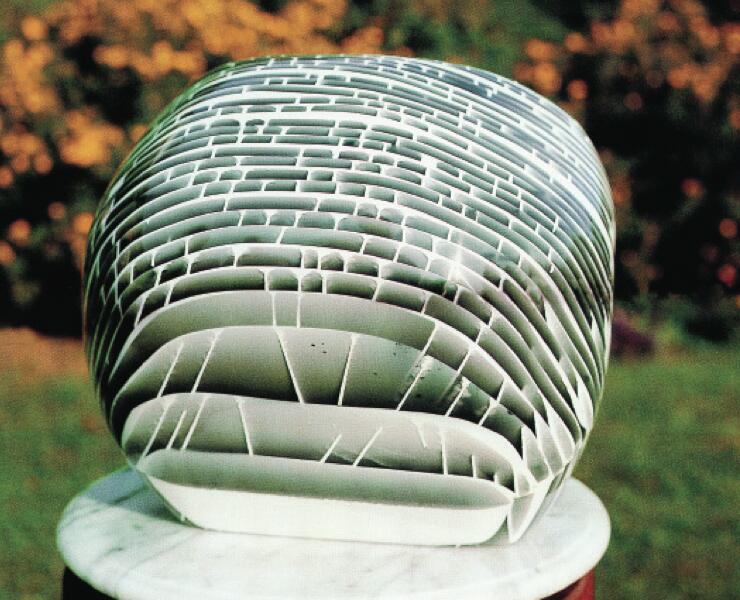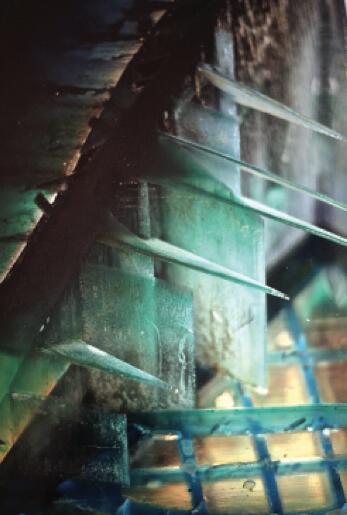Monique Rozanès
KALEIDOSCOPES
They look like exotic jewels from an Arabian Nights’ tale. Resembling none other, multicolored, multiform, transparent or iridescent, they are rendered in a material reminiscent of amber, sometimes of rubies, sometimes of onix, emeralds or alabaster. Some appear to adopt organic shapes - a seal – or the shapes of man-made objects – the keel of a ship, a totem, or even a tribute to Brancusi, the brilliant Romanian sculptor.

We are referrring to the work of an artist with a long and fruitful trajectory, Monique Rozanès, a small and powerful woman who was born in Bordeaux in 1936 and lived many years in Argentina, after she fell in love with an artist, Leopoldo Torres Agüero, with whom she shared many years of her life. She created a unique technique that allowed her to take advantage of a contemporary material like acrylic; superimposing layer upon layer through a special fusion method, and then applying a polishing procedure that contributes a crystalline finish, she differentiated herself from her colleagues because she dared use a support that must compete with nobler ones such as wood, marble or bronze. Through this technique she creates an explosion of colors that none of the traditional materials would allow her to achieve. Her production is not restrained to the novelty of the material; she approaches different subjects like an archaeologist ready to extract materials from the depths of her excavations, and then she shows these works in series like the ones of the Samurai, the Wheels, the Heads, the Doors, the Obelisks, the Stellae, and the Burmese Stellae, to name just a few.
In the 1990s, Rozanès began her series of the Samurai, monumental monolithic sculptures, all of them reaching almost three meters in height, and evoking the caste of warriors of ancient Japan; the armors, and above all the helmets, showed a detailed elaboration that the sculptress successfully achieved through infinite layers of color. Independently of the formal attraction, these works evince an admiration for the samurai way of life, their ethical and behavioral code, known as bushido, and also for the studies of literature, philosophy and history that these warriors embarked on in times of peace. This is one of the best achieved series in her entire production; testimonies of this are the Samurai with the Blue Triangle, the Samurai with Flower, or the Two-headed Samurai, but above all, the Samurai from La Rioja, inspired by her partner, Leopoldo Torres Agüero. Apart from Japan, Rozanès also found inspiration in Southeast Asia, especially after a trip she made to Cambodia and Burma in 2002. Schwedagon, the golden pagoda in Yangon; the burning sunsets of the Pagan plain interspersed with brick sanctuaries and an infinity of other Buddhist monuments opened the doors to an overwhelming creativity. The story goes that those Burmese sovereigns, incited by their faith, strove to erect magnificent pagodas, entirely covered in gold, at the expense of a people that became impoverished and suffered famines and plagues, until a merciful king came to the throne and forbade the construction of golden pagodas, a law that would be considered preposterous at present. Rozanès incorporates tenuous gold sheets in her series of Burmese Dreams, to evoke that disproportionate luxury. Within her work, gold renews its sacred properties, perceived by so many ancient peoples, such as the Egyptians and the Incas, who corroborated the presence of the divinity in this precious metal; gold has a commercial exchange value, but man has historically considered it a symbol of the unalterable and the pure; not for nothing did the ancient alchemists say Aurum nostrum, non est aurum vulgi (our gold is not the gold of the people). Rozanès’s approach to these cultures is not only formal; suffice it to check the titles of her works: one of the Burmese stellae is titled Dharma, the specific name of the Buddha’s fundamental teachings, the Four Noble Truths that led man along a path resulting in less suffering, and that he expounded for the first time in the Gazelles Park at Sarnath. This knowledge of the oriental culture dated bak to earlier years; in 1995 Rozanès created an impressive work, Sentinelle de la Kundalini (Sentinel of the Kundalini), an acrylic totem in black and white variations, which clearly shows three allusions to the inferior chakras (energy centers), three allusions to the superior centers and one to the crown chakra or portal along which the Kundalini serpent (an invisible energy represented by this reptile) ascends after going through the six mentioned points.
Of course not everything is Oriental inspiration for Rozanès. Pre- Columbian America, its myths, its culture and its art have also kindled her creative fire, as evidenced in her Doors series, which pay tribute to the famous Gate of the Sun of Bolivia’s Tiahuanaco culture. Her sensibility also allows her to address themes from nature, imaginary portraits, geometries and multiple evocations. What is the origin of such passion for forms? Perhaps the answer may be found in a lesson she learned in the presence of the mountains, when filled with wonder at such beauty she attempted to paint the landscape. At that moment, the master that materializes when the disciple is ready to listen appeared before her and told her that she should “be the mountain”, grasp its essence, since only then would she be capable of representing it through her art. Rozanès never practiced zazen (the Japanese Zen meditation) because she did not need to; she quickly understood the lesson, and since then she found it easy to become immersed in anything that fascinated her. Then, in her workshop, she created these multicolored jewels, a genuine kaleidoscope of emotions.
Profile:
Monique Rozanès was born in Bordeaux, France. She studied at the École Nationale Supérieure des Arts Décoratifs (Paris). Since 1956 she has presented numerous solo shows in Argentina and abroad, in the following museums: Chartres (France), la Chaux de Fonds (Switzerland), Saint-Léger (Soissons-France), La Rioja (Argentina); also in galleries such as P. Fachetti (Paris and Zurich), Art Shop (Bále - Switzerland), Rubbers, Praxis, Van Eyck and Kramer (Bs. As.), Arlette Gimaray (Paris), Sluis (Holland). Lelia Mordoch (Paris), Altera Gallery (Pinamar, Argentina). She was awarded the Grand Prize for Sculpture at the Alexandria International Biennial and the First Prize at the National Salon (Argentina).










